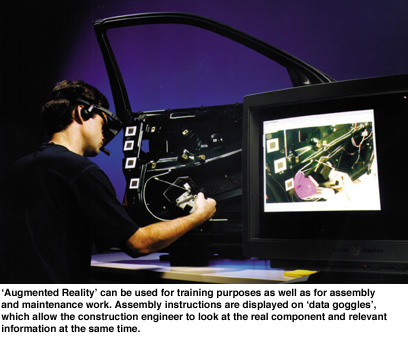
ERCIM News No.44 - January 2001 [contents]

![]()
ERCIM News No.44 - January 2001 [contents]
by Hellmuth Nordwig
Augmented Reality is the term given by research scientists to a completely new, fascinating technique which inserts additional information directly into our view of the real world. The Fraunhofer Institute for Computer Graphics Research IGD in Darmstadt is one of the participants in the ARVIKA pilot project sponsored by the German Federal Ministry of Education and Research BMBF, working on new technology that helps people to see more than what is visible in real life. ARVIKA creates future-oriented solutions for industry, in volving interaction between human beings and technologies.
In a decade’s time it could be possible to take a trip in Augmented Reality. “Initial research work has been under way for three years in this field”, reports one of the pioneers: Dr. Stefan Müller, head of the Visualization and Virtual Reality department at the Fraunhofer Institute for Computer Graphics Research in Darmstadt. Virtual, or computer-simulated reality, is already shaping the everyday work of architects, designers and planners of products and assembly processes. Before the prototype of a new car is built, for example, the engineers put the model and its assembly through the most diverse variants on the computer using CAD and CAM programs. Rather than on-screen, such imaging acquires much more realistic form if presented in a ‘CAVE’, the facility installed at the IGD for three-dimensional projections.

“The key aspect of Augmented Reality is to superimpose virtual worlds on top of the real view of an object”, explains Stefan Müller. This is interesting wherever 3D digital data is already available as a result of the object being designed or dimensioned using a computer. Some exemplary scenarios indicate potential applications: In the assembly hangar at an aircraft factory: The assembly engineer is standing on the wing and routing the cables for the control surface electronics. The virtual assembly instructions show him step by step which strand of cable has to be routed where. He has both hands free and does not have to keep getting down from the wing to study the layout plan.
In the operating theatre: The surgeon has the patient’s medical parameters in view at all times and does not need to move his eyes away to look for data on monitors. In virtually planned heart or brain operations the surgeon can also reach the diseased tissue by precisely the route he has envisaged. This minimizes the risk for the patient.
In the office of a town planner or architect: What will be the least obtrusive site for a pedestrian bridge over the Thames near St. Paul’s Cathedral? Does this lamp match the planned interior design, will it illuminate the required area? Such questions frequently crop up in practice but the answers to them are, unfortunately, normally not very reliable. Augmented Reality can prevent many a false move from the outset.
Augmented Reality technology requires many innovative technological solutions, of which some have been developed at the IGD. The key unit is a portable computer – not a cumbersome laptop, but an extremely powerful mini-computer, which can be attached to the user’s belt – because car mechanics and surgeons need both hands when they are working. Then there are the data-glasses which in their simplest configuration consist of a transparent LCD. In another variant a tiny screen is attached to the frame of the glasses, from which information is directed to the lens. This lens is actually a transparent mirror which guides the information into the sight of the wearer. Another alternative for the future could be ‘Virtual Retinal Displays’, in which the image is projected by laser straight into the eye.
Stefan Müller describes one of the main challenges for the IGD’s research scientists: “We had to teach the computer in particular how to recognize where the user is looking”. The best solution turned out to be a tiny camera fastened to the data-glasses and sending 25 images per second to the computer. This compares the image information with previously stored orientation points on the object and calculates the user’s current position and line of vision.
Many details still remain to be solved. The range of applications is, however, simply limitless. More and more products and facilities are designed on computer nowadays, and it would be beneficial if planners could see how their ideas fit into the real environment. Augmented Reality is set to provide the missing link for Man-Machine-Interaction in the Knowledge-Based Society.
Links:
http://www.inigraphics.net/publications/brochures/vr_ar.html.en
Please contact:
Stefan Müller - Fraunhofer-Gesellschaft
Tel: +49 61 51/1 55-1 88
E-mail: stefan.mueller@igd.fhg.de